Eight PEER graduate students and several PEER faculty members had the opportunity to visit Japan from March 1 � 7, 2009 for a unique educational experience. The students were from six of PEER's core institutions including UC Davis, UCLA, UC San Diego, USC, University of Washington, and UC Berkley. They were invited by the Center for Urban Earthquake Engineering (CUEE) headquartered at Tokyo Institute of Technology to participate in several activities including a Young Researchers Workshop, the CUEE Annual Conference in Tokyo, observation of a shaking table test at the E-Defense Facility in Miki City and visit to the Disaster Reduction Museum in Kobe.

[from left to right] CUEE Hosts: Assistant Professor Ken Watanabe, Dr. Atsushi Tanabe. PEER Students: Barbara Chang (UCSD), Patrick Wilson (UCSD), Maud Comboul (USC), Changzheng Liu (UCD), Andre Barbosa (UCSD), Eric Yee (UCLA), Anna Birely (UW), Tracy Becker (UCB). PEER Faculty/Staff: Professor Ross Boulanger (UCD), Steve McCabe (NEES Inc.), PEER Director Stephen Mahin, PEER Outreach Director Heidi Faison.
At the Young Researchers Workshop one day before the start of the CUEE conference, the PEER students were able to present their research to other young professors and graduate students from Japan. In this setting they were able to share their research experiences and learn from the experiences/projects of their international colleagues. The event, sponsored by CUEE, was intended to help establish relationships between the young researchers and provide a foundation for future collaboration in research. The afternoon workshop was followed by a dinner where the students could relax and visit with their new colleagues. According to PEER student Andre Barbosa from UC San Diego, "this workshop along with the following dinner hosted by CUEE served as a very good way to establish contacts between Japanese and US researchers. On a personal note, the dinner was also a great way to be introduced to some Japanese culture and Japanese food. My unease with the use of chopsticks brought about an interesting trait of the Japanese culture. Researchers sitting at my table, noticing my lack of experience and reduced success with the use of chopsticks, started taking some of the food off the plates with their own hands so that I would feel more comfortable! For me, this was an unforgettable moment, and showed the true spirit of cooperation and friendship that can be established between young researchers, a spirit that is the pillar of any joint research and future exchange of scientific information."
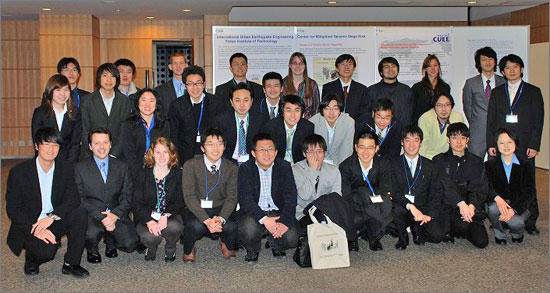
Participants in the Young Researcher Workshop sponsored by CUEE.

PEER graduate student Anna Birley from the University of Washington presents her research at the Young Researcher Workshop.
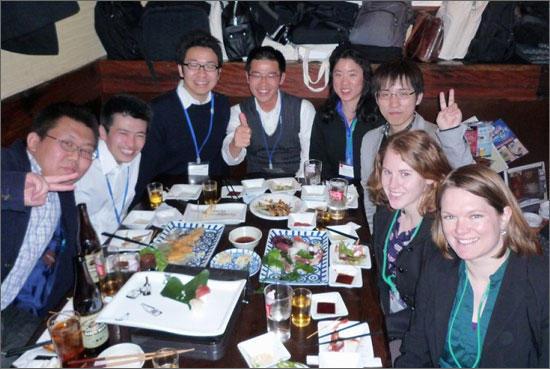
The following CUEE conference exposed the students to the latest research in many fields. PEER student Eric Yee from UCLA "learned a lot on this trip, especially on the different types of research the conference participants were conducting and a sort of who's who. I've read many of the work by some of the conference organizers and it was good to actually meet some of them and place a face to a name." Additionally, the students had the opportunity to display posters about their research for judging by many experts in the field of earthquake engineering. PEER students Barbara Chang and Patrick Wilson from UC San Diego both won awards for Best Poster along with two Japanese colleagues.

PEER graduate student Patrick Wilson from UCSD explains his research to a Japanese colleague.
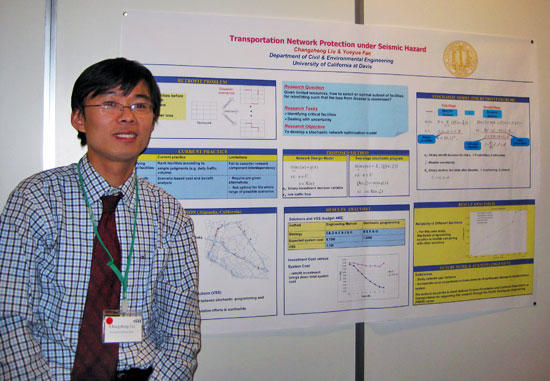
PEER graduate student Changzheng Liu from UC Davis with his poster at the CUEE Conference Poster Session.
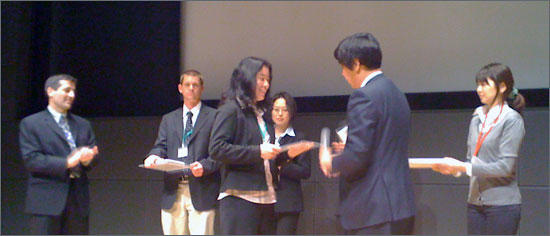
PEER graduate student Barbara Chang from UCSD receives the "Best Poster" award along with three other students.

PEER graduate student Andre Barbosa from UCSD with his poster at the CUEE Conference Poster Session.
After the conference, the PEER students and faculty took the Japanese ShiUnkansen bullet train south to the city of Kobe. From Kobe it was a short bus ride to the E-Defense Shaking Table Facility in Miki City. Andre Barbosa shares his experience of the journey: "In the trip from Tokyo to Kobe, I was also very fortunate to sit next to Professor Stephen Mahin, the actual PEER director and a leading world expert in earthquake engineering and seismic performance of buildings and bridges. I had a unique opportunity of showing him some of the work that I am developing as a PhD candidate and got very constructive feedback and great advice for my future research. It was one of the most remarkable moments in this trip, one which would probably never come about without this tour to E-Defense and Kobe, and for this I am also very grateful to PEER and CUEE."
At the E-Defense Facility the students received a tour of the laboratory including the old specimens and had the opportunity to observe a test of a steel buckling restrained brace frame structure. According to Andre Barbosa, "Once we reached E-Defense, I was overwhelmed with the size and capabilities of this Japanese facility...It was an extraordinary experience to see the five-story building shaken at the base in 3 directions with such apparent ease, by a peak shake table acceleration of about 0.90 g. The building behaved very well and showed little damage proving that BRB building systems can be designed effectively to withstand seismic excitations with reduced structural and non-structural damage." PEER student Patrick Wilson found the facility equally impressive. "The site visit was an educational experience that was humbling, but encouraging. In order to take full advantage of testing on such a large and expensive scale, collaboration between the US, Japanese, and all other researchers should clearly be a priority." In an impromptu briefing at the conclusion of the testing, the Chairman of the E-Defense Steel Building Project, Professor Kazuhiko Kasai shared details of the test setup, procedure, and the results as they were processed.
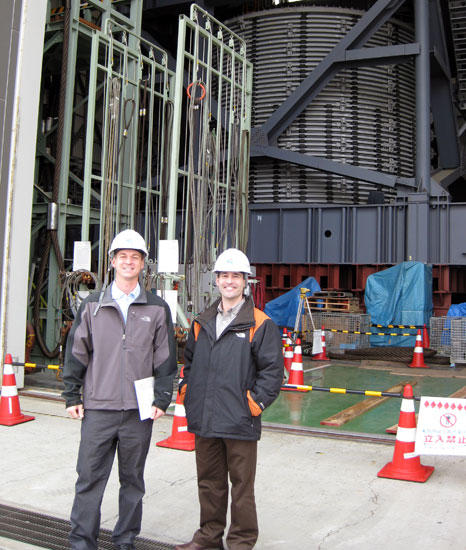
Geotechnical Engineering student Patrick Wilson and Professor Ross Boulanger at the
E-Defense large-scale cylindrical laminar container.

Structural Engineering students Andre Barbosa, Anna Birely, and Barbara Chang investigate a damaged low-rise RC school building specimen.
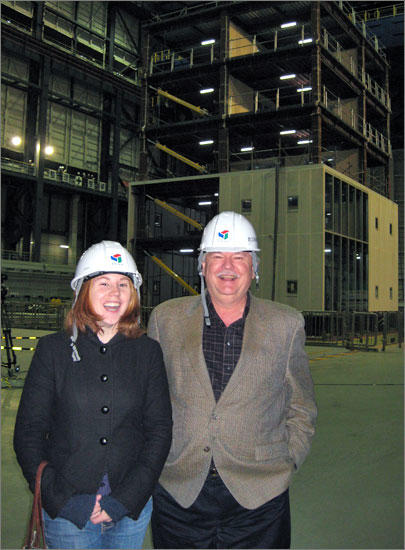
UC Berkeley student Tracy Becker and her adviser Professor Stephen Mahin,
Director of the PEER Center, in the E-Defense Shaking Table Laboratory with the
steel buckling restrained brace frame structure that was tested later that afternoon.
On the last day of the program, the students had the opportunity to visit the Disaster Reduction Museum in Kobe which is a combination of a memorial exhibit about the Kobe earthquake of 1995 and a disaster prevention/preparedness resource for the community. PEER student Barbara Chang from UC San Diego shares about her experiences at the museum: "As a structural engineer, I found the presentations and exhibit very tragic but also affirming in my career choice; other civil engineers would no doubt feel the same. There were also some fascinating but simple experimental exhibits which showed the effects of liquefaction, the advantages of braces or shear walls in structures, and also household-installed elements to improve non-structural safety." The visit to this unique museum that concluded the week's activities also reminded the students about how their research is important to making earthquake resistant communities. The museum exhibits and tour further emphasized that technical solutions also need to address the human element of earthquakes.

PEER students Maud Comboul, Eric Yee, Tracy Becker, Barbara Chang and Anna Birely at the Disaster Reduction Museum in Kobe, Japan.

PEER students Eric Yee, Barbara Chang, Anna Birely and PEER Outreach Director Heidi Faison enjoy the structural demonstration models on the hand operated shaking table in the Kobe Disaster Reduction Museum
The continual effort to encourage interaction between the Japanese and PEER students was a key element to the success of this educational program. During the week's events they were able to get to know each other personally as well as professionally. "I was able to establish some personal relationships with Japanese researchers and other PEER students. I was also able to meet renowned US and Japanese professors and had some very informative conversations with some of them. These were unique experiences that were only made possible by the active spirit of cooperation in research between PEER and CUEE, and their drive for education of their young researchers. This trip has also served as a great motivation for taking on the final tasks for completing my PhD, and, if I am so blessed, for later embarking on the life journey of a research and professorship." The experience of Andre Barbosa stated here echoes the thoughts voiced by many of the PEER students through out the week long program.
PEER thanks CUEE for initiating and supporting this incredible experience for PEER graduate students.
posted April 06, 2009
